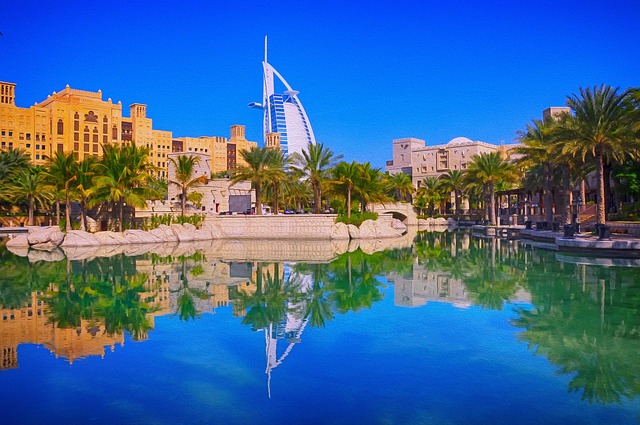The Ultimate Guide to Palm Jumeirah: Exploring Dubai’s Iconic Man-Made Island for You
Palm Jumeirah is a man-made island that is located off the coast of Dubai, United Arab Emirates (UAE). The island is designed in the shape of a palm tree and is one of the largest artificial islands in the world. It was created as a part of Dubai’s plan to develop its tourism industry, and since its completion in 2006, it has become one of the most popular destinations in the city.

History of Dubai’s Iconic Man-Made Palm Jumeirah
Palm Jumeirah was conceptualized and developed by the Dubai government in 2001. The project was undertaken by Nakheel Properties, a Dubai-based real estate development company. The construction of the island involved dredging millions of cubic meters of sand from the sea bed and using it to create the palm-shaped island. The project took over six years to complete, and it cost an estimated $12 billion.
Features of Dubai’s Iconic Man-Made Palm Jumeirah
This is a massive engineering marvel that is home to many luxurious hotels, resorts, and private residences. Here are some of the key features of Palm Jumeirah:
- Palm Jumeirah Monorail: This monorail runs along the length of the island, providing easy access to the hotels and resorts on the island.
- Atlantis, The Palm: Atlantis, The Palm is one of the most iconic landmarks on the island. It is a five-star hotel and resort that features a water park, an aquarium, and many other amenities.
- Nakheel Mall: Nakheel Mall is a luxury shopping mall located on the island. It features many high-end fashion brands, restaurants, and entertainment options.
- The Pointe: The Pointe is a waterfront dining and entertainment destination that is home to many restaurants and shops.
- Private Residences: Palm Jumeirah is also home to many private residences, including villas and apartments, that offer stunning views of the Dubai skyline.
Impact on Dubai’s Economy
Palm Jumeirah has had a significant impact on Dubai’s economy. The island has become one of the top tourist destinations in the city, attracting millions of visitors every year. It has also spurred the development of many other projects in Dubai, including other man-made islands and skyscrapers.
Sustainability of Palm Jumeirah
Despite its massive size, Palm Jumeirah is designed to be sustainable. The island features many green spaces, including parks and gardens, which help to improve air quality and reduce the urban heat island effect. The island also features a state-of-the-art wastewater treatment plant, which helps to conserve water resources.
Challenges faced during construction
The construction of Palm Jumeirah was not without its challenges. One of the biggest challenges was the environmental impact of the project. Dredging millions of cubic meters of sand from the sea bed can have a significant impact on marine life and ecosystems. The project also faced many technical challenges, such as designing and constructing the Palm Jumeirah Monorail.
An amazing journey awaits you in the United Arab Emirates. Book your tickets as soon as possible and experience its majestic beauty for yourself! You won’t be disappointed – it is an unbelievable country with a plethora of incredible experiences.
The Cost of Staying at Palm Jumeirah
Staying at Palm Jumeirah can be a luxurious and unforgettable experience, but it comes at a price. Here are some of the costs associated with staying at Palm Jumeirah:
- Accommodation: Palm Jumeirah offers a range of accommodation options, from luxury hotels to private residences. Prices for hotels and resorts on the island can vary widely depending on the level of luxury and the time of year. Private residences on the island can cost millions of dollars.
- Dining: Palm Jumeirah is home to many fine dining restaurants and bars, but they can be expensive. Expect to pay a premium for meals and drinks on the island.
- Activities: Palm Jumeirah offers many activities for visitors, including water sports, shopping, and sightseeing. These activities can be costly, but they offer unique and memorable experiences.
Palm Jumeirah: Who Can Visit?
Palm Jumeirah is open to visitors from all over the world. Anyone can visit the island and enjoy its amenities, including hotels, restaurants, shopping, and activities. However, certain areas of the island, such as private residences and beaches, may be restricted to residents or members only. It’s important to check with individual establishments or tour operators to see if there are any restrictions on access. Additionally, visitors should be aware of local customs and laws, and dress appropriately to respect the culture and traditions of the UAE.
Palm Jumeirah: Is Admission Free?
Admission to Palm Jumeirah is free, however, the costs of staying or engaging in activities on the island can be expensive.
What are nearby airports to Palm Jumeirah?
Palm Jumeirah is located in Dubai, United Arab Emirates, and there are two main airports that serve the city: Dubai International Airport (DXB) and Al Maktoum International Airport (DWC). Both airports are located within a 30-minute drive from Palm Jumeirah, making it easily accessible for travelers.
Top 10 airlines that fly to Abu Dhabi International Airport (AUH), in no particular order:
- Etihad Airways
- Emirates – Emirates Airlines special fares and coupons
- Air India
- Turkish Airlines
- Qatar Airways
- Gulf Air
- EgyptAir
- KLM Royal Dutch Airlines
- British Airways
- Lufthansa
Palm Jumeirah is a massive engineering marvel that has become one of the most popular tourist destinations in Dubai. The island is home to many luxurious hotels, resorts, and private residences, and it has had a significant impact on Dubai’s economy. Despite its massive size, Palm Jumeirah is designed to be sustainable, and it features many green spaces and a state-of-the-art wastewater treatment plant.
To know more about this https://en.wikipedia.org/wiki/Palm_Jumeirah
